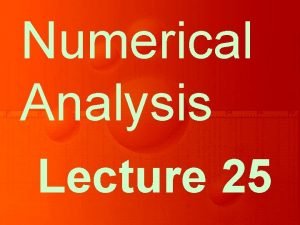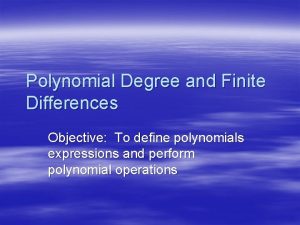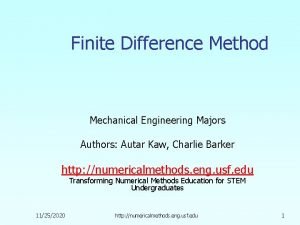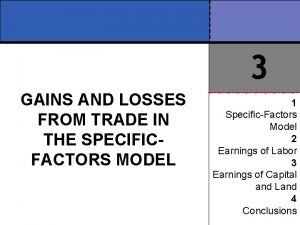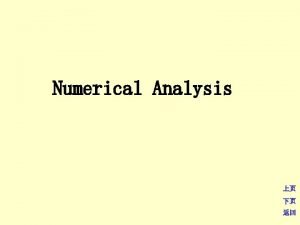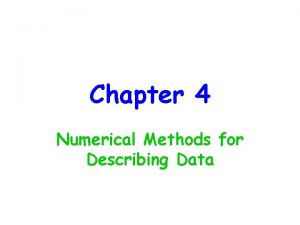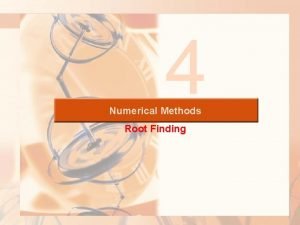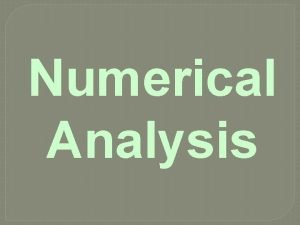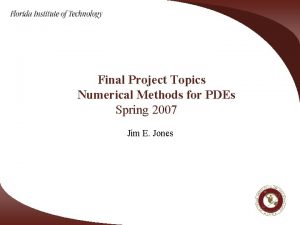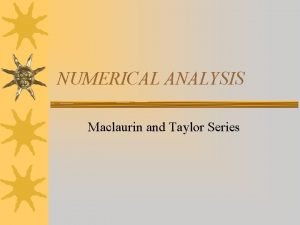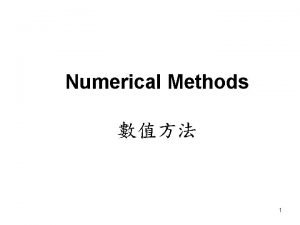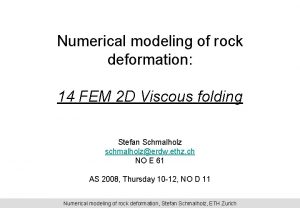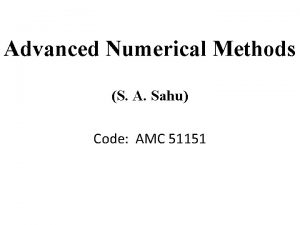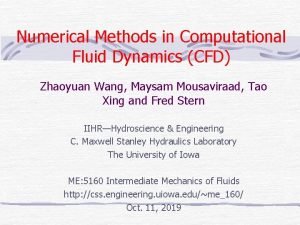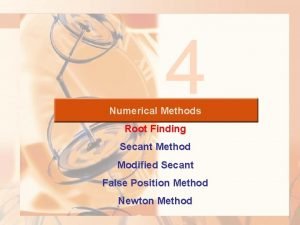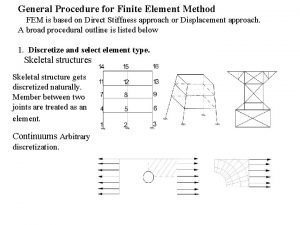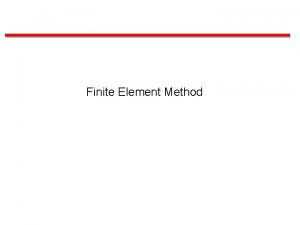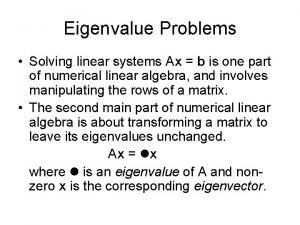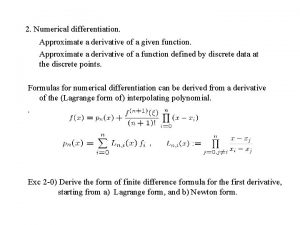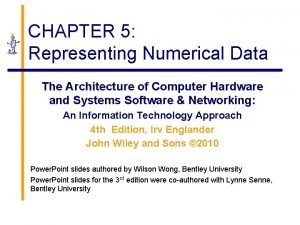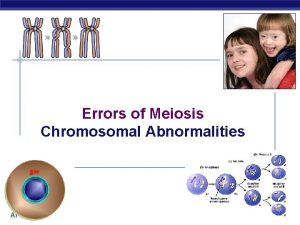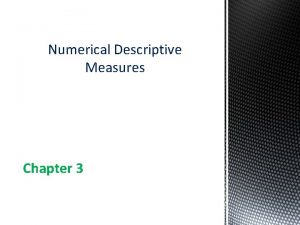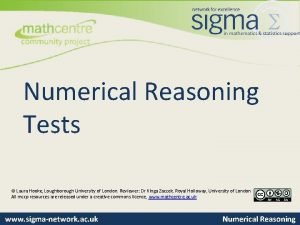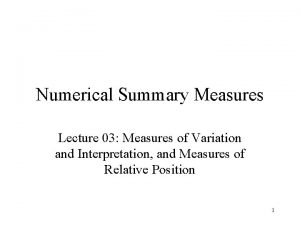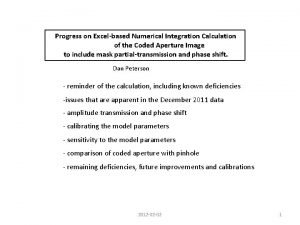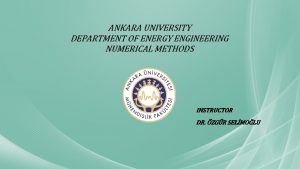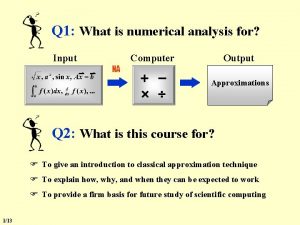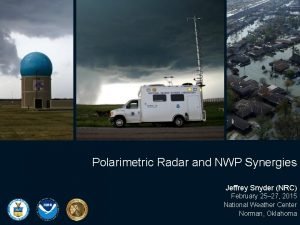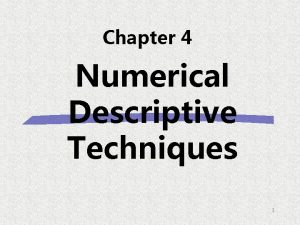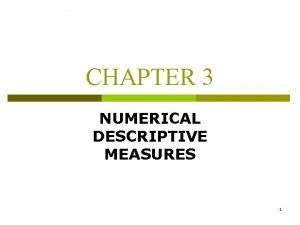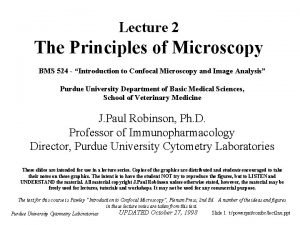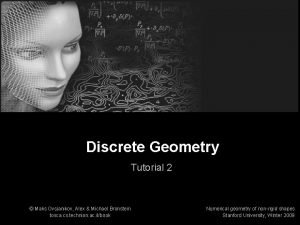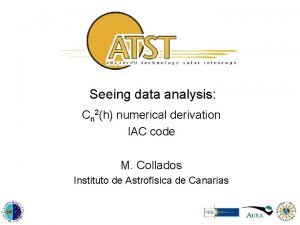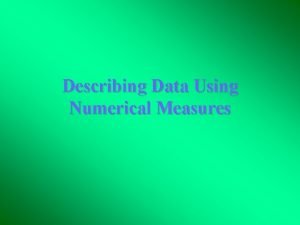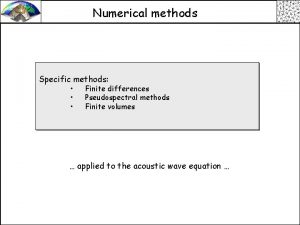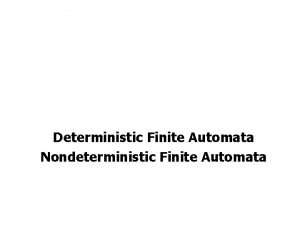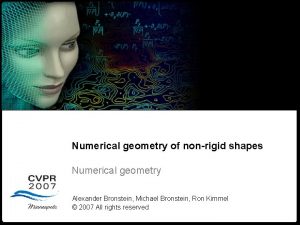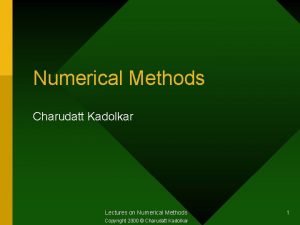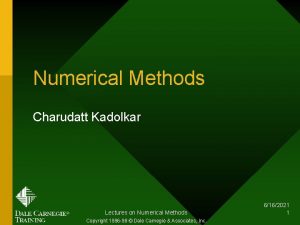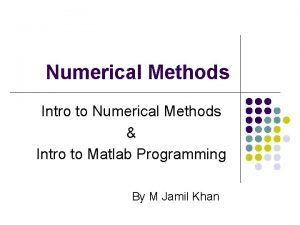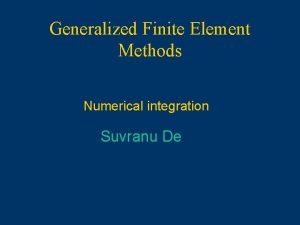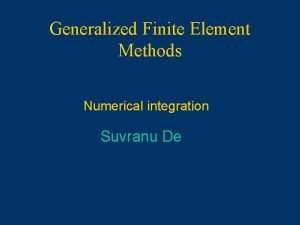Numerical methods Specific methods Finite differences Pseudospectral methods





























































- Slides: 61

Numerical methods Specific methods: • • • Finite differences Pseudospectral methods Finite volumes … applied to the acoustic wave equation …

Why numerical methods Example: seismic wave propagation Seismometers Generally heterogeneous medium explosion … we need numerical solutions! … we need grids! … And big computers …

Partial Differential Equations in Geophysics The acoustic wave equation - seismology P c s C k v R p pressure acoustic wave speed sources tracer concentration diffusivity flow velocity reactivity sources - acoustics - oceanography - meteorology Diffusion, advection, Reaction - geodynamics - oceanography - meteorology - geochemistry - sedimentology - geophysical fluid dynamics

Numerical methods: properties Finite differences - time-dependent PDEs - seismic wave propagation - geophysical fluid dynamics - Maxwell’s equations - Ground penetrating radar -> robust, simple concept, easy to parallelize, regular grids, explicit method Finite elements - static and time-dependent PDEs - seismic wave propagation - geophysical fluid dynamics - all problems -> implicit approach, matrix inversion, well founded, irregular grids, more complex algorithms, engineering problems Finite volumes - time-dependent PDEs - seismic wave propagation - mainly fluid dynamics -> robust, simple concept, irregular grids, explicit method

Other Numerical methods: Particle-based methods - lattice gas methods - molecular dynamics Boundary element methods - problems with boundaries (rupture) - based on analytical solutions Pseudospectral methods - orthogonal basis functions, special case of FD - spectral accuracy of space derivatives - granular problems - fluid flow - earthquake simulations -> very heterogeneous problems, nonlinear problems - only discretization of planes --> good for problems with special boundary conditions (rupture, cracks, etc) - wave propagation, GPR -> regular grids, explicit method, problems with strongly heterogeneous media

What is a finite difference? Common definitions of the derivative of f(x): These are all correct definitions in the limit dx->0. But we want dx to remain FINITE

What is a finite difference? The equivalent approximations of the derivatives are: forward difference backward difference centered difference

The big question: How good are the FD approximations? This leads us to Taylor series. .

Our first FD algorithm (ac 1 d. m) ! P c s pressure acoustic wave speed sources Problem: Solve the 1 D acoustic wave equation using the finite Difference method. Solution:

Problems: Stability: Careful analysis using harmonic functions shows that a stable numerical calculation is subject to special conditions (conditional stability). This holds for many numerical problems.

Problems: Dispersion True velocity Dispersion: The numerical approximation has artificial dispersion, in other words, the wave speed becomes frequency dependent. You have to find a frequency bandwidth where this effect is small. The solution is to use a sufficient number of grid points per wavelength.

Our first FD code! % Time stepping for i=1: nt, % FD disp(sprintf(' Time step : %i', i)); for j=2: nx-1 d 2 p(j)=(p(j+1)-2*p(j)+p(j-1))/dx^2; % space derivative end pnew=2*p-pold+d 2 p*dt^2; % time extrapolation pnew(nx/2)=pnew(nx/2)+src(i)*dt^2; % add source term pold=p; % time levels p=pnew; p(1)=0; % set boundaries pressure free p(nx)=0; % Display plot(x, p, 'b-') title(' FD ') drawnow end

Snapshot Example

Seismogram Dispersion

Finite Differences - Summary • • • Conceptually the most simple of the numerical methods and can be learned quite quickly Depending on the physical problem FD methods are conditionally stable (relation between time and space increment) FD methods have difficulties concerning the accurate implementation of boundary conditions (e. g. free surfaces, absorbing boundaries) FD methods are usually explicit and therefore very easy to implement and efficient on parallel computers FD methods work best on regular, rectangular grids

The Fourier Method - What is a pseudo-spectral Method? - Fourier Derivatives - The Fast Fourier Transform (FFT) - The Acoustic Wave Equation with the Fourier Method - Comparison with the Finite-Difference Method - Dispersion and Stability of Fourier Solutions Numerical Methods in Geophysics The Fourier Method

What is a pseudo-spectral Method? Spectral solutions to time-dependent PDEs are formulated in the frequency-wavenumber domain and solutions are obtained in terms of spectra (e. g. seismograms). This technique is particularly interesting for geometries where partial solutions in the -k domain can be obtained analytically (e. g. for layered models). In the pseudo-spectral approach - in a finite-difference like manner - the PDEs are solved pointwise in physical space (x-t). However, the space derivatives are calculated using orthogonal functions (e. g. Fourier Integrals, Chebyshev polynomials). They are either evaluated using matrix multiplications or the fast Fourier transform (FFT). Numerical Methods in Geophysics The Fourier Method

Fourier Derivatives . . let us recall the definition of the derivative using Fourier integrals. . . we could either. . . 1) perform this calculation in the space domain by convolution 2) actually transform the function f(x) in the k-domain and back Numerical Methods in Geophysics The Fourier Method

The Fast Fourier Transform . . . the latter approach became interesting with the introduction of the Fast Fourier Transform (FFT). What’s so fast about it ? The FFT originates from a paper by Cooley and Tukey (1965, Math. Comp. vol 19 297 -301) which revolutionised all fields where Fourier transforms where essential to progress. The discrete Fourier Transform can be written as Numerical Methods in Geophysics The Fourier Method

The Fast Fourier Transform. . . this can be written as matrix-vector products. . . for example the inverse transform yields. . . where. . . Numerical Methods in Geophysics The Fourier Method

The Fast Fourier Transform. . . the FAST bit is recognising that the full matrix - vector multiplication can be written as a few sparse matrix - vector multiplications (for details see for example Bracewell, the Fourier Transform and its applications, Mac. Graw-Hill) with the effect that: Number of multiplications full matrix FFT N 2 2 Nlog 2 N this has enormous implications for large scale problems. Note: the factorisation becomes particularly simple and effective when N is a highly composite number (power of 2). Numerical Methods in Geophysics The Fourier Method

The Fast Fourier Transform Number of multiplications Problem 1 D (nx=512) 1 D (nx=2096) 1 D (nx=8384) full matrix 2. 6 x 105 FFT Ratio full/FFT 9. 2 x 103 28. 4 94. 98 312. 6 . . the right column can be regarded as the speedup of an algorithm when the FFT is used instead of the full system. Numerical Methods in Geophysics The Fourier Method

Acoustic Wave Equation - Fourier Method let us take the acoustic wave equation with variable density the left hand side will be expressed with our standard centered finite-difference approach . . . leading to the extrapolation scheme. . . Numerical Methods in Geophysics The Fourier Method

Acoustic Wave Equation - Fourier Method where the space derivatives will be calculated using the Fourier Method. The highlighted term will be calculated as follows: multiply by 1/ . . . then extrapolate. . . Numerical Methods in Geophysics The Fourier Method

Acoustic Wave Equation - 3 D . . where the following algorithm applies to each space dimension. . . Numerical Methods in Geophysics The Fourier Method

Comparison with finite differences - Algorithm let us compare the core of the algorithm - the calculation of the derivative (Matlab code) Numerical Methods in Geophysics The Fourier Method

Comparison with finite differences - Algorithm . . . and the first derivative using FFTs. . . simple and elegant. . . Numerical Methods in Geophysics The Fourier Method

Fourier Method - Dispersion and Stability . . . with the usual Ansatz we obtain . . . leading to Numerical Methods in Geophysics The Fourier Method

Fourier Method - Dispersion and Stability What are the consequences? a) when dt << 1, sin-1 (kcdt/2) kcdt/2 and w/k=c -> practically no dispersion b) the argument of asin must be smaller than one. Numerical Methods in Geophysics The Fourier Method

Fourier Method - Comparison with FD - 10 Hz Example of acoustic 1 D wave simulation. FD 3 -point operator red-analytic; blue-numerical; green-difference Numerical Methods in Geophysics The Fourier Method

Fourier Method - Comparison with FD - 10 Hz Example of acoustic 1 D wave simulation. FD 5 -point operator red-analytic; blue-numerical; green-difference Numerical Methods in Geophysics The Fourier Method

Fourier Method - Comparison with FD - 10 Hz Example of acoustic 1 D wave simulation. Fourier operator red-analytic; blue-numerical; green-difference Numerical Methods in Geophysics The Fourier Method

Fourier Method - Comparison with FD - 20 Hz Example of acoustic 1 D wave simulation. FD 3 -point operator red-analytic; blue-numerical; green-difference Numerical Methods in Geophysics The Fourier Method

Fourier Method - Comparison with FD - 20 Hz Example of acoustic 1 D wave simulation. FD 5 -point operator red-analytic; blue-numerical; green-difference Numerical Methods in Geophysics The Fourier Method

Fourier Method - Comparison with FD - 20 Hz Example of acoustic 1 D wave simulation. Fourier operator red-analytic; blue-numerical; green-difference Numerical Methods in Geophysics The Fourier Method

Fourier Method - Comparison with FD - Table Difference (%) between numerical and analytical solution as a function of propagating frequency Simulation time 5. 4 s 7. 8 s 33. 0 s Numerical Methods in Geophysics The Fourier Method

Numerical solutions and Green’s Functions The concept of Green’s Functions (impulse responses) plays an important role in the solution of partial differential equations. It is also useful for numerical solutions. Let us recall the acoustic wave equation with being the Laplace operator. We now introduce a delta source in space and time the formal solution to this equation is (Full proof given in Aki and Richards, Quantitative Seismology, Freeman+Co, 1981, p. 65) Numerical Methods in Geophysics The Fourier Method

Numerical solutions and Green’s Functions In words this means (in 1 D and 3 D but not in 2 D, why? ) , that in homogeneous media the same source time function which is input at the source location will be recorded at a distance r, but with amplitude proportional to 1/r. An arbitrary source can evidently be constructed by summing up different delta - solutions. Can we use this property in our numerical simulations? What happens if we solve our numerical system with delta functions as sources? Numerical Methods in Geophysics The Fourier Method

Numerical solutions and Green’s Functions Source is a Delta function in space and time 3 point operator 5 point operator Fourier Method Impulse response (analytical) Time steps Numerical Methods in Geophysics Impulse response (numerical The Fourier Method

Numerical solutions and Green’s Functions Numerical Methods in Geophysics Fourier Method Impulse response (numerical convolved with source 5 point operator Impulse response (analytical) concolved with source Frequency increases 3 point operator The Fourier Method

Fourier Method - Summary The Fourier Method can be considered as the limit of the finite-difference method as the length of the operator tends to the number of points along a particular dimension. The space derivatives are calculated in the wavenumber domain by multiplication of the spectrum with ik. The inverse Fourier transform results in an exact space derivative up to the Nyquist frequency. The use of Fourier transform imposes some constraints on the smoothness of the functions to be differentiated. Discontinuities lead to Gibb’s phenomenon. As the Fourier transform requires periodicity this technique is particular useful where the physical problems are periodical (e. g. angular derivatives in cylindrical problems). Numerical Methods in Geophysics The Fourier Method

Finite Elements – the concept How to proceed in FEM analysis: • Divide structure into pieces (like LEGO) • Describe behaviour of the physical quantities in each element • Connect (assemble) the elements at the nodes to form an approximate system of equations for the whole structure • Solve the system of equations involving unknown quantities at the nodes (e. g. displacements) • Calculate desired quantities (e. g. strains and stresses) at selected elements

Finite Elements – Why? FEM allows discretization of bodies with arbitrary shape. Originally designed for problems in static elasticity. FEM is the most widely applied computer simulation method in engineering. Today spectral elements is an attractive new method with applications in seismology and geophysical fluid dynamics The required grid generation techniques are interfaced with graphical techniques (CAD). Today a large number of commercial FEM software is available (e. g. ANSYS, SMART, MATLAB, ABACUS, etc. )

Finite Elements – Examples

Discretization – finite elements As we are aiming to find a numerical solution to our problem it is clear we have to discretize the problem somehow. In FE problems – similar to FD – the functional values are known at a discrete set of points. . regular grid. . . irregular grid. . . Domain D The key idea in FE analysis is to approximate all functions in terms of basis functions j, so that

Finite elements – basic formulation Let us start with a simple linear system of equations |*y and observe that we can generally multiply both sides of this equation with y without changing its solution. Note that x, y and b are vectors and A is a matrix. We first look at Poisson’s equation (e. g. , wave equation without time dependence) where u is a scalar field, f is a source term and in 1 -D

Formulation – Poisson’s equation We now multiply this equation with an arbitrary function v(x), (dropping the explicit space dependence) . . . and integrate this equation over the whole domain. For reasons of simplicity we define our physical domain D in the interval [0, 1]. . why are we doing this? . . . be patient. . .

Partial Integration. . . partially integrate the left-hand-side of our equation. . . we assume for now that the derivatives of u at the boundaries vanish so that for our particular problem

. . . so that we arrive at. . . with u being the unknown function. This is also true for our approximate numerical system . . . where. . . was our choice of approximating u using basis functions.

The basis functions we are looking for functions ji with the following property . . . otherwise we are free to choose any function. . . The simplest choice are of course linear functions: + grid nodes blue lines – basis functions ji

The discrete system The ingredients: . . . leading to. . .

The discrete system. . . the coefficients ck are constants so that for one particular function jk this system looks like. . . probably not to your surprise this can be written in matrix form

The solution. . . with the even less surprising solution remember that while the bi’s are really the coefficients of the basis functions these are the actual function values at node points i as well because of our particular choice of basis functions.

Basis functions and element Quadrangles Trangles Linear Quadratic

The Acoustic Wave Equation 1 -D How do we solve a time-dependent problem such as the acoustic wave equation? where v is the wave speed. using the same ideas as before we multiply this equation with an arbitrary function and integrate over the whole domain, e. g. [0, 1], and after partial integration . . we now introduce an approximation for u using our previous basis functions. . .

The Acoustic Wave Equation 1 -D note that now our coefficients are time-dependent!. . . and. . . together we obtain which we can write as. . .

Time extrapolation M mass matrix A stiffness matrix b . . . in Matrix form. . . remember the coefficients c correspond to the actual values of u at the grid points for the right choice of basis functions. . . How can we solve this time-dependent problem?

FD extrapolation . . . let us use a finite-difference approximation for the time derivative. . . leading to the solution at time tk+1: we already know how to calculate the matrix A but how can we calculate matrix M?

Matrix assembly Mij Aij % assemble matrix Mij % assemble matrix Aij M=zeros(nx); A=zeros(nx); for i=2: nx-1, for j=2: nx-1, if i==j, M(i, j)=h(i-1)/3+h(i)/3; A(i, j)=1/h(i-1)+1/h(i); elseif j==i+1 elseif i==j+1 M(i, j)=h(i)/6; A(i, j)=-1/h(i-1); elseif j==i-1 elseif i+1==j M(i, j)=h(i)/6; A(i, j)=-1/h(i); else M(i, j)=0; A(i, j)=0; end end end

Numerical example – regular grid This is a movie obtained with the sample Matlab program: femfd. m

Finite Elements - Summary • • • FE solutions are based on the “weak form” of the partial differential equations FE methods lead in general to a linear system of equations that has to be solved using matrix inversion techniques (sometimes these matrices can be diagonalized) FE methods allow rectangular (hexahedral), or triangular (tetrahedral) elements and are thus more flexible in terms of grid geometry The FE method is mathematically and algorithmically more complex than FD The FE method is well suited for elasto-static and elastodynamic problems (e. g. crustal deformation)
 Non finite subordinate clause
Non finite subordinate clause Finite and non finite
Finite and non finite Learning objectives for finite and non finite verbs
Learning objectives for finite and non finite verbs Learning objectives of non finite verbs
Learning objectives of non finite verbs Finite and non-finite verb
Finite and non-finite verb Newton central difference interpolation formula
Newton central difference interpolation formula Finite differences polynomials
Finite differences polynomials Finite differences
Finite differences Finite differences exponential functions
Finite differences exponential functions Specific factors model numerical example
Specific factors model numerical example Differential equations calculator
Differential equations calculator Interpolation in numerical methods
Interpolation in numerical methods Chronicle of higher education
Chronicle of higher education Birge vieta method examples
Birge vieta method examples Define backward difference in interpolation
Define backward difference in interpolation Numerical methods final project
Numerical methods final project Descriptive statistics numerical measures
Descriptive statistics numerical measures Taylor series numerical methods
Taylor series numerical methods Numerical methods
Numerical methods Numerical methods for partial differential equations eth
Numerical methods for partial differential equations eth Stirling interpolation formula proof
Stirling interpolation formula proof Types of errors in numerical analysis
Types of errors in numerical analysis Error aleatorio formula
Error aleatorio formula What are numerical method in cfd
What are numerical method in cfd Ordinary differential equations example
Ordinary differential equations example Secant root finding
Secant root finding Graphical method numerical analysis
Graphical method numerical analysis Finite element method
Finite element method Finite element method
Finite element method Pharmaceutical application of specific gravity
Pharmaceutical application of specific gravity Specific weight to density
Specific weight to density Solving numerical problems
Solving numerical problems Numerical differentiation
Numerical differentiation C programming lectures
C programming lectures Lithuanian language
Lithuanian language Representing numerical data
Representing numerical data Turner syndrome is what numerical chromosome disorder?
Turner syndrome is what numerical chromosome disorder? Linear monomial example
Linear monomial example Numerical descriptive measures exercises
Numerical descriptive measures exercises Numerical expression
Numerical expression Dark field microscopy
Dark field microscopy Shl verbal reasoning test
Shl verbal reasoning test Numerical summary
Numerical summary Numerical integration
Numerical integration Numerical
Numerical Mathematical preliminaries in numerical computing
Mathematical preliminaries in numerical computing Numerical model
Numerical model Erlanger classification
Erlanger classification Jack in box
Jack in box Significado de vicarius filii dei 666
Significado de vicarius filii dei 666 Xiaolin wu's line algorithm
Xiaolin wu's line algorithm Visual numerical learning style
Visual numerical learning style Numerical descriptive statistics
Numerical descriptive statistics C++ program for numerical differentiation
C++ program for numerical differentiation Grometry
Grometry Numerical geometry of non-rigid shapes
Numerical geometry of non-rigid shapes Numerical derivation
Numerical derivation Optical fiber light propagation
Optical fiber light propagation Local attraction in surveying
Local attraction in surveying Programs that organize analyze and graph numerical data
Programs that organize analyze and graph numerical data Numerical
Numerical Banker's algorithm request
Banker's algorithm request





